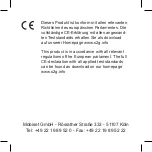
Page 30
5.1 Room EQ
General
The parameter settings of the O 500 C have
been optimized by K + H in the way, that in a
non-reflecting surrounding there will be a liner
frequency response at the system.
Such a reflection-free surriunding will not be
possible under practical conditions- on the
contrary- room and positioning of the monitors
will lead to significant unlinearties in the
frequency-response.
How inlinearities of the frequeny-response are
generated by the location in the room.Base of
this acoustic reaction is the principle of
interferences of soundwaves. In general, there
will be always two or more sound waves needed,
which are generated from two sources with a
certain distance to each other.
two interfearing signals may to the double level
(0°-phase shift) or a complete cancellation of a
frequency (180°-phase shift). In between these
two figures all levels/phaseshifts are possible.
How to use the internal room-EQ Feature
The O 500 C is offering three powerful functions
for the compensation of unlinearities in the
frequency response, which were caused by the
monitor’s location: The compensation through
individually generated parameter setups (
chapter 6.4), the fully parametric EQ ( chapter
5.2) plus the comfortable local EQ-function, as
described below. All adjustments will be made
in the menu
1 EQ Set
of the EQ-menu. On the
following pages all options from this menu will
be introduced, including some typical examples.
Important notes
When adjusting the local EQ function please
keep in mind that the examples given here are
not a strict line to be followed, they are just a
recommendation how to do it practically.
After every adjustment we recommend to listen
carefully to the system by a selection of well-
known music. It would be advantageous to make
a plot of the resulted frequncy response before
and after the adjustment, so it can be seen from
the curves how the frequency curves have been
changed.
The last point takes a very important role, as
here will be the largest influence to the relation
of absorption or reflection of sound energy, and
the level of the secondary soundsources.
Fig. 5.1/1: Low Cut function, plotted from 30...80
Hz (in steps of 10 Hz)
The number of frequencies or ranges of
frequencies of such a frequency influenced by
interferences can hardly be determined, as their
levels, phases and results are depending on
many factors, which cannot be calculated or
eliminated, such as:
-The distances between test-microphone ( or
listening area ) to the monitor and any reflecting
surface
-The dispersion of the speaker-system over the
whole frequency-range
-Various
Eigenschaften
of the surface-
structure, material, mecanical construction etc.
Interferences will always occur, if two or more
signal sources are active in a room. One of these
sources is the monitor itself, so it is called the
PRIMARY SOURCE.
Secondary signal sources are generated by the
dispersion of the primary source, which is
reflected from various surfaces, such as walls,
ceiling, windows, floor, and even furniture and
decoration in that room.The diffusion of a
soundwave on any surface is determined by two
parameters: the bending of the soundwave at
the edges of the surface and the reflection from
it’s plain surface, if it is larger than the wavelength
of the soundwave’s frequency.
These reflected secondary soundwaves are
interfering with the primary waves from the
monitor, and will lead to an audible difference.
Low Cut
With this function it is possible to adjust the
low frequency cut off of the complete system.
The low cut can be set between 30 Hz and
80 Hz in steps of 10 Hz with a steepness of
12dB per octave:








































